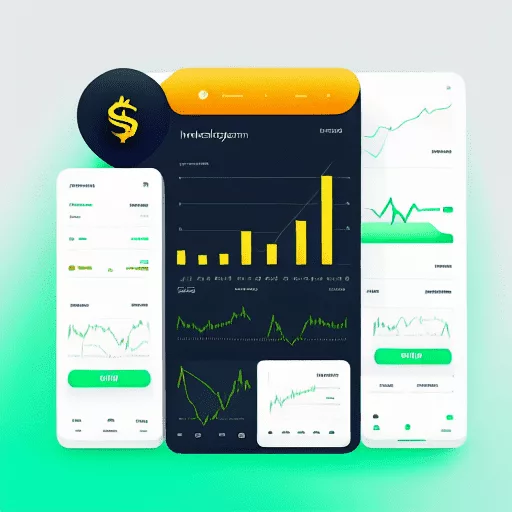Crypto day trading’s unstable environment can often seem like being lost at sea without any guidance tools. The erratic behavior of the markets can swirl you into a tempest of fear and avarice, leading to an all too simple loss of direction.
However, with the right tools at your disposal, you can confidently chart your course and make informed trading decisions. One of the most essential tools in a crypto trader’s arsenal is technical indicators, which can uncover hidden patterns and provide valuable insight into the market’s behavior.
As a fellow crypto enthusiast, I’ve spent countless hours researching and experimenting with various indicators to identify the best ones for day trading. It’s important to recognize that there’s no one-size-fits-all solution, and the key to success is finding the right combination of indicators that resonate with your trading style and objectives.
In this article, we’ll explore some of the most powerful and widely used indicators in the world of crypto trading, and I’ll share my personal insights on how to effectively harness their potential. From moving averages to oscillators, these indicators can help you gain the upper hand in the fast-paced world of cryptocurrencies and instill a sense of mastery in your trading endeavors.
So grab your captain’s hat and let’s set sail on this exciting journey together!
Harness the Power of Simple and Exponential Moving Averages in Crypto Trading
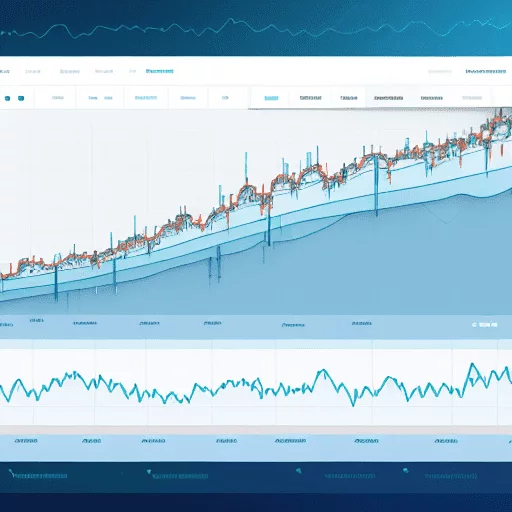
As a crypto trader, I can’t stress enough the importance of understanding moving averages in trend analysis. They’re crucial for making well-informed decisions. Grasping the differences between Simple Moving Averages (SMA) and Exponential Moving Averages (EMA) is essential for identifying the best indicators for my crypto day trading strategies.
By applying these moving averages, I’m able to capitalize on market trends and maximize my investment returns.
Understanding the Importance of Moving Averages in Trend Analysis
Imagine you’re a sailor navigating the choppy seas of the market, and moving averages are your trusty compass guiding you through the waves of trends, helping you chart a course towards potential gains. As a technical analysis tool, the moving average indicator plays a critical role in trend analysis for crypto day trading.
By observing the price chart, you can uncover three key insights that will fuel your desire for mastery:
- Moving averages helps identify the overall direction of the market, allowing you to distinguish between bullish and bearish trends.
- They smooth out price fluctuations, providing a clearer picture of the market’s behavior and enabling you to spot potential entry and exit points.
- Moving averages also act as dynamic support and resistance levels, giving you the confidence to take calculated risks and maximize your returns.
As you delve deeper into the world of moving averages, you’ll soon discover the nuances and differences between simple moving averages (SMA) and exponential moving averages (EMA), further refining your navigational skills in the vast ocean of crypto trading.
Differentiating Between Simple Moving Averages (SMA) and Exponential Moving Averages (EMA)
Diving into the world of moving averages, you’ll quickly notice the key differences between Simple Moving Averages (SMA) and Exponential Moving Averages (EMA), allowing you to sharpen your skills and navigate the ever-changing tides of the market.
The two types of moving averages provide unique insights to help refine your crypto day trading approach, making it essential for you to understand the nuances of both. To make it easier, let’s compare them to a simple table:
| Simple Moving Averages (SMA) | Exponential Moving Averages (EMA) |
|---|---|
| Gives equal weight to all data points | Prioritizes recent data points with more weight |
| Slower to react to price changes | Faster to react to price changes |
| Better for identifying long-term trends | Better for identifying short-term trends |
As you can see, simple moving averages are perfect for analyzing long-term trends, while exponential moving averages excel in detecting short-term price movements.
By incorporating both types of moving averages into your technical analysis, you can harness the best of both worlds, leading to more informed and strategic decision-making. With this newfound understanding, you’re ready to dive deeper into applying moving averages to your crypto day trading strategies, ensuring you stay ahead of the game.
Applying Moving Averages to Your Crypto Day Trading Strategies
Incorporating moving averages into your strategies is like adding a trusty compass to your arsenal, guiding you through the twists and turns of the market with ease. By applying moving averages, such as SMA and EMA, to your crypto day trading strategies, you can more effectively identify trends, support and resistance levels, and potential entry and exit points. These are the best indicators for crypto trading that allow you to make informed decisions, increasing your chances of success in this fast-paced market.
Remember, mastery comes with practice and persistence, so keep refining your trading strategies with the help of moving averages.
Now that we’ve covered moving averages, let’s dive into another powerful tool you can use: the Relative Strength Index (RSI). This tool helps identify overbought and oversold conditions in crypto assets.
Use RSI for Identifying Overbought and Oversold Conditions in Crypto Assets
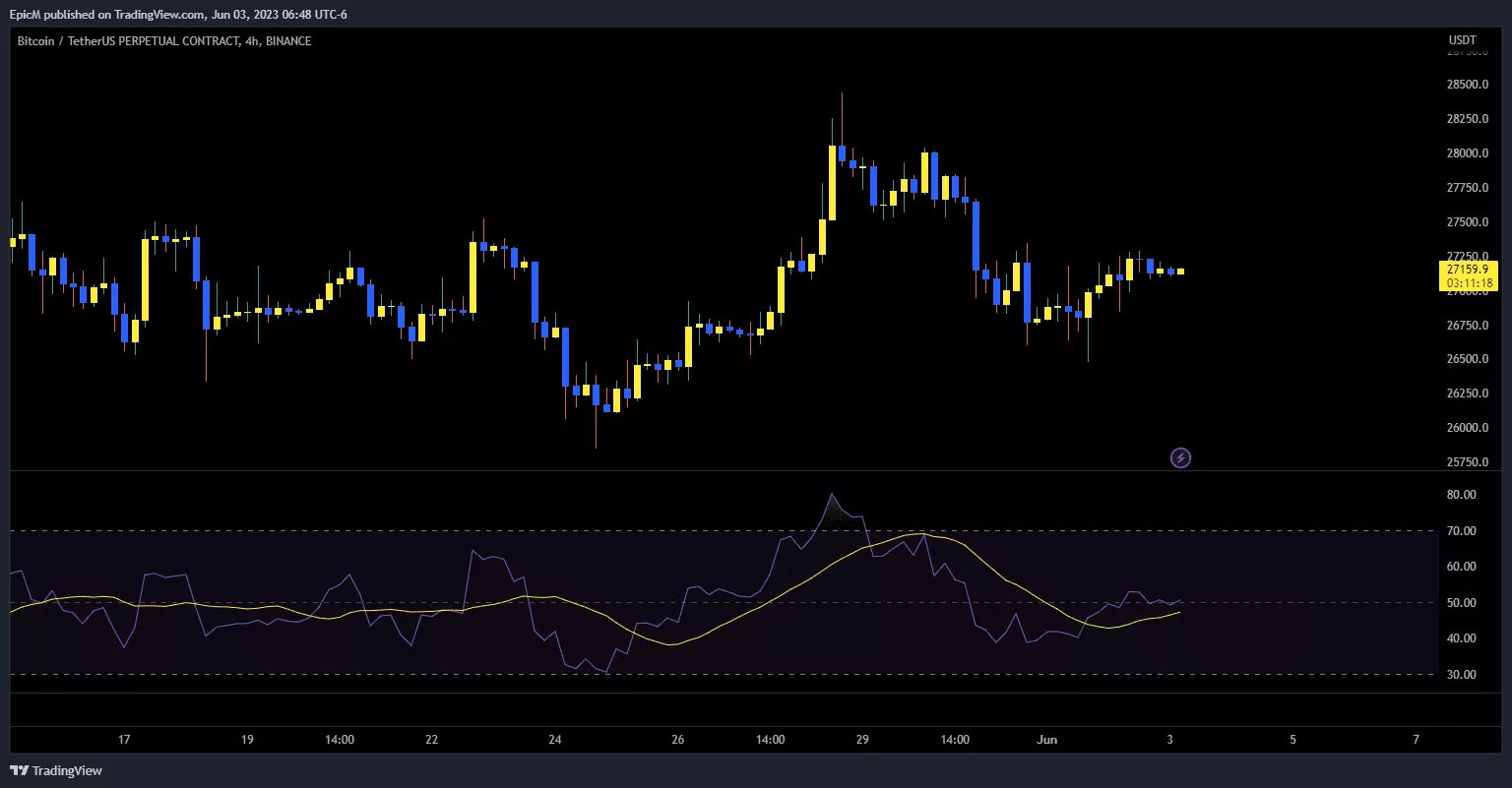
In today’s discussion, we’ll delve into the basics of the Relative Strength Index (RSI) Indicator. It’s a powerful tool for identifying overbought and oversold conditions in crypto assets.
We’ll explore how to interpret RSI values to make informed trading decisions. We’ll enhance your accuracy by combining RSI with other essential indicators. Join me as we unlock the full potential of this crucial element in our crypto trading arsenal.
The Basics of the Relative Strength Index (RSI) Indicator
Picture the RSI Indicator as a compass guiding you through the turbulent waves of market trends. It helps you make informed decisions on your trading journey. The Relative Strength Index is a powerful trading indicator that can provide valuable insights into the momentum of a crypto asset. This makes it a critical tool for crypto day trading.
By measuring the speed and change of price movements, RSI helps you determine whether an asset is overbought or oversold. This ensures you can identify potential reversals and make well-timed trades. As a trend indicator, RSI can also help you confirm the strength of a trend and avoid getting caught in false breakouts.
With the knowledge of this indispensable tool, you’ll be better equipped to navigate the ever-changing world of cryptocurrencies. Soon enough, you’ll be interpreting RSI values like a pro to make informed trading decisions.
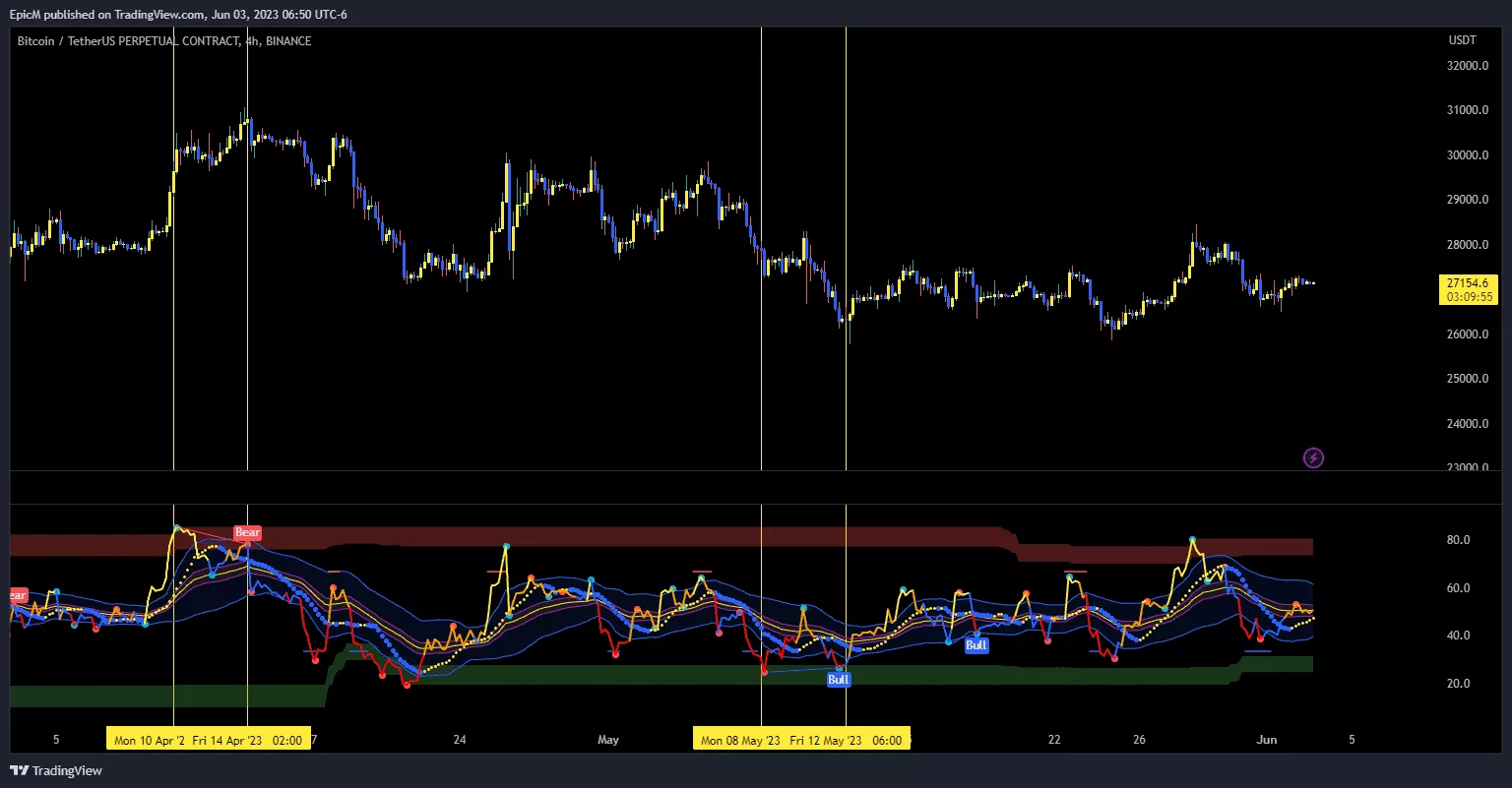
Interpreting RSI Values to Make Informed Trading Decisions
With RSI values as your trusty compass, you’ll sail smoothly through the choppy waters of market trends, making well-informed decisions on when to buy or sell assets like a seasoned captain.
Interpreting RSI values is a crucial part of leveraging this potent tool for crypto day trading. As one of the best indicators in technical analysis, RSI values will help you identify overbought or oversold conditions, guiding your informed trading decisions.
When the RSI value rises above 70, it signals an overbought market, and it may be a good time to consider selling. Conversely, when the RSI value dips below 30, the market is likely to oversold, and it could be an opportune moment to buy.
However, don’t forget that RSI is just one piece of the puzzle. To truly master the art of crypto day trading, you’ll want to enhance your RSI strategy by combining it with other tools for even greater accuracy.
Stay tuned as we dive into the exciting world of synergistic trading techniques.
Combining the RSI Indicator with Other Tools for Enhanced Accuracy
As you venture further into your trading journey, you’ll find that combining the RSI indicator with other tools can significantly enhance your accuracy and decision-making prowess.
In the realm of crypto day trading, where every second counts, a well-rounded approach to analyzing the market is essential. To achieve this, you can merge the RSI with other indicators for cryptocurrency trading, such as the Moving Average Convergence Divergence (MACD), Bollinger Bands, or the Fibonacci Retracement tool.
By incorporating multiple technical analysis methods, you maximize your chances of identifying reliable entry and exit points, reducing the risk of false signals or missed opportunities.
In the next section, we’ll explore how you can leverage the MACD indicator to detect crypto market reversals and further refine your trading strategy.
Leverage the MACD Indicator to Detect Crypto Market Reversals
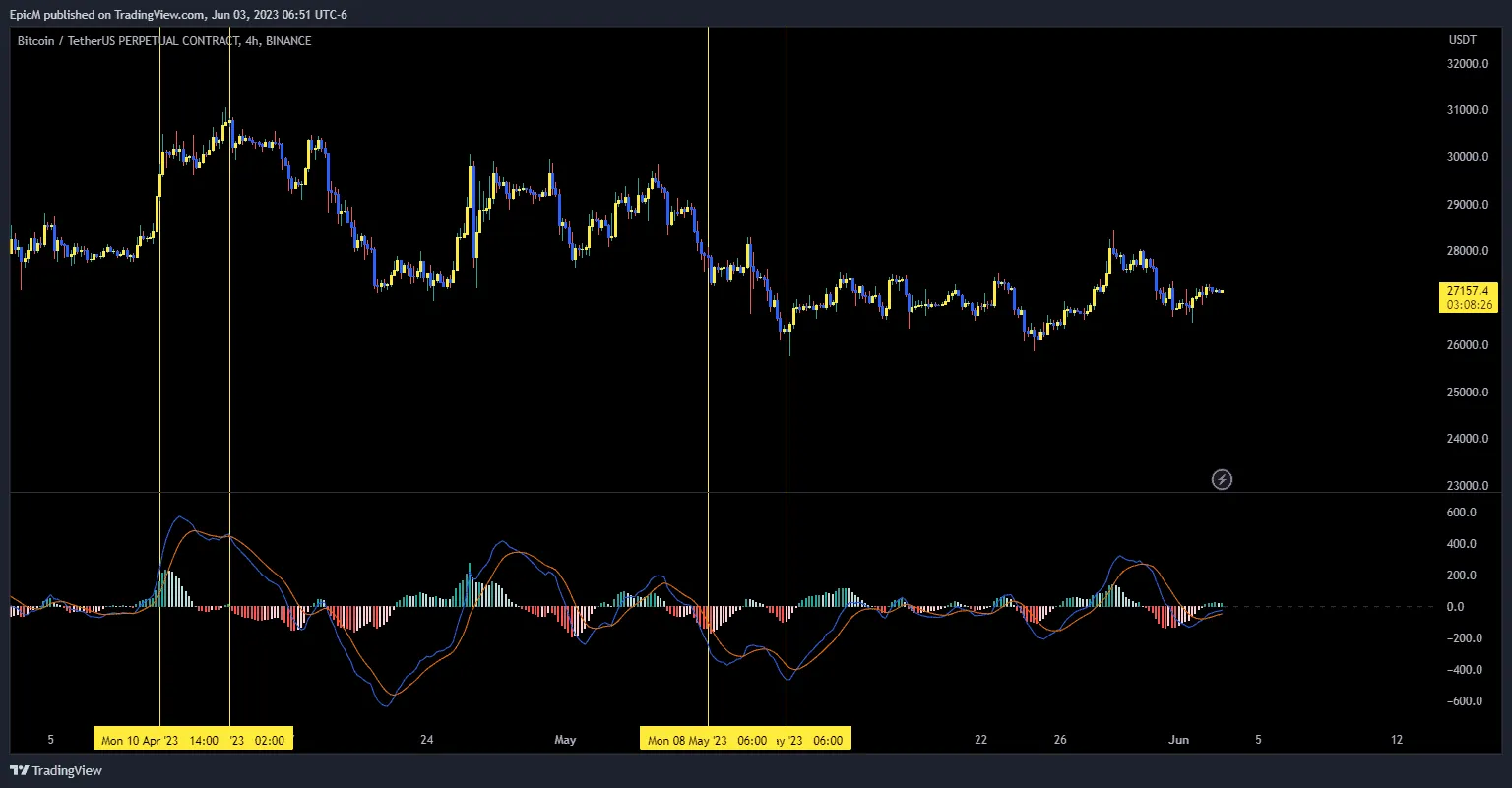
As a day trader, I’ve found that leveraging the MACD indicator is crucial for detecting crypto market reversals.
By understanding the components and signals of the MACD indicator, analyzing crypto price movements through divergence and convergence patterns, and integrating MACD into my day trading techniques, I’ve achieved better results in my trading strategies.
Let’s dive into how we can use the MACD indicator to help us navigate the volatile world of crypto trading.
Understanding the Components and Signals of the MACD Indicator
Diving into the MACD indicator, it’s crucial to grasp its components and signals for successful implementation in your trading strategy.
The MACD indicator comprises four key elements, which are:
- MACD Line: This is calculated by subtracting the 26-day Exponential Moving Average (EMA) from the 12-day EMA of the closing price.
- Signal Line: A 9-day EMA of the MACD Line, which acts as a trigger for trading signals.
- Histogram: The visual representation of the difference between the MACD Line and the Signal Line, providing insight into market momentum.
- Zero Line: A baseline to determine whether the MACD Line and Signal Line are positive or negative, showing bullish or bearish market conditions.
Using these components, we can derive trading signals when the MACD Line crosses the Signal Line, either above or below it. When the MACD Line crosses above the Signal Line, it’s a bullish signal, and when it crosses below, it’s a bearish signal.
Remember, though, that it’s essential to use indicators in combination with other technical analysis tools to increase the accuracy of your predictions.
Now that we’ve got a handle on the MACD indicator’s components, let’s explore how to analyze crypto price movements through divergence and convergence patterns.
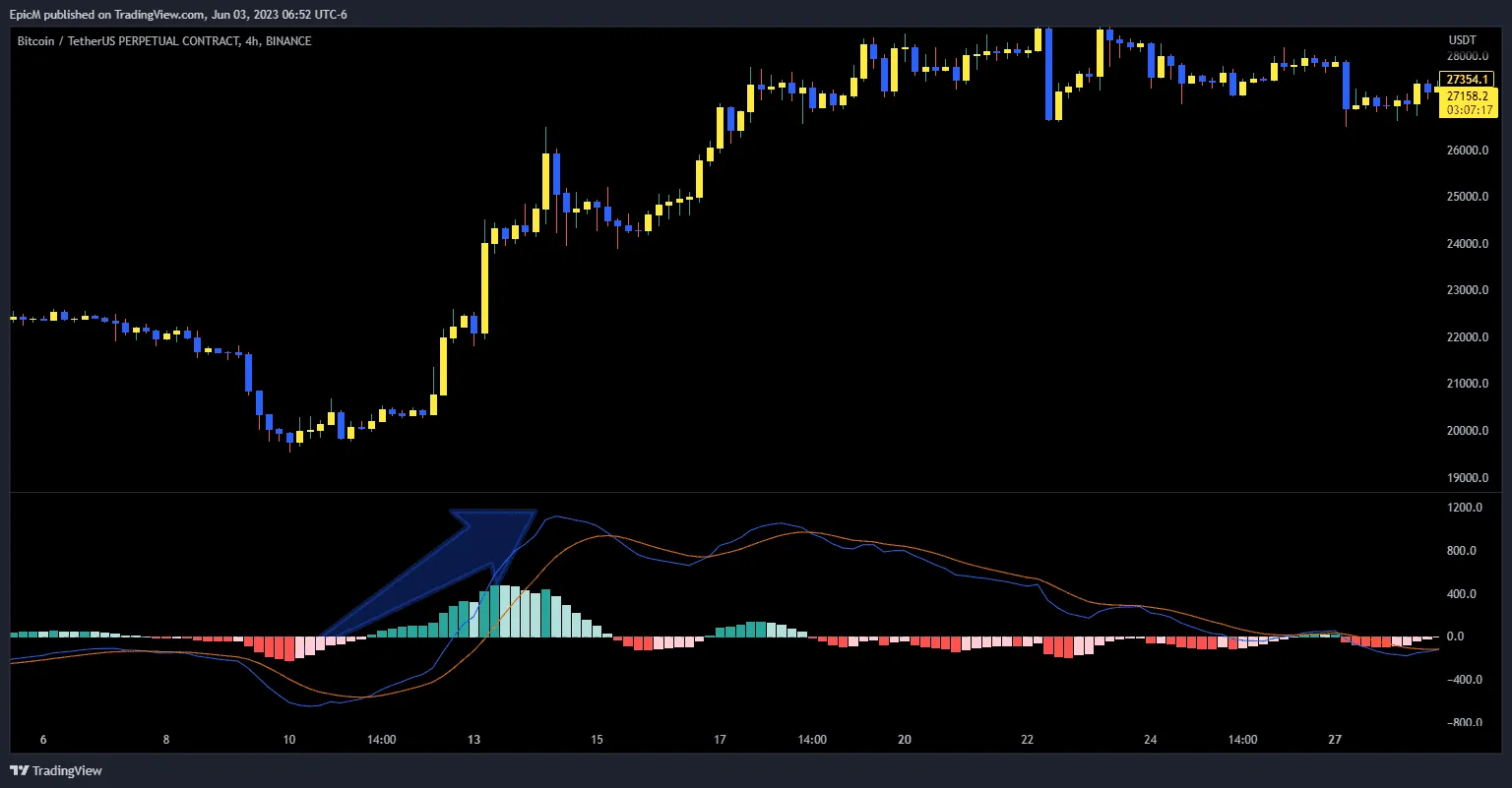
Analyzing Crypto Price Movements Through Divergence and Convergence Patterns
You’ll be absolutely blown away by how effectively you can analyze cryptocurrency price movements using divergence and convergence patterns with the MACD indicator!
As a day trader, recognizing these patterns can provide valuable insights into the potential future direction of the price of a cryptocurrency. By incorporating crypto trading indicators like divergence and convergence patterns, you’ll be able to make well-informed decisions on when to enter or exit a trade, thus increasing your chances of success.
It’s crucial to remember that the MACD indicator works best in combination with other indicators, so don’t rely solely on it for your trading decisions. As you gain experience and confidence in your abilities, you’ll find that mastering the art of identifying these patterns can significantly enhance your trading strategy.
Now, let’s dive into integrating MACD into your day trading techniques for even better results!
Integrating MACD into Your Day Trading Techniques for Better Results
Incorporating MACD into your day trading techniques can improve your results and help you make more informed decisions in the fast-paced world of cryptocurrency. The MACD (Moving Average Convergence Divergence) indicator is one of the most popular technical analysis indicators used by traders, as it allows you to pinpoint potential buy or sell signals in the market.
Here are four ways to integrate this powerful trading tool into your strategy:
- Identify crossovers: When the MACD line crosses above the signal line, it’s a bullish signal, showing it might be a good time to buy. Conversely, when the MACD line crosses below the signal line, it’s a bearish signal, suggesting that it might be time to sell.
- Spot divergence: If the price of a cryptocurrency is rising but the MACD line is falling, this divergence may show an upcoming price reversal. Similarly, if the price is falling but the MACD line is rising, it could signal a potential upward trend.
- Observe overbought and oversold conditions: When the MACD line reaches extreme highs or lows, it’s possible that the cryptocurrency is overbought (highs) or oversold (lows). This can help you identify potential entry and exit points for your trades.
- Combine with other technical analysis indicators: For even better results, use the MACD with other technical analysis tools, such as moving averages, RSI, or Fibonacci retracements, to gain a more comprehensive understanding of the market and make smarter decisions.
By integrating the MACD indicator into your day trading techniques, you’ll be well-equipped to navigate the volatile world of cryptocurrency trading. With these insights in hand, let’s dive into another powerful tool to enhance your crypto trading insight: Bollinger Band analysis.
Enhance Your Crypto Trading Insight with Bollinger Band Analysis
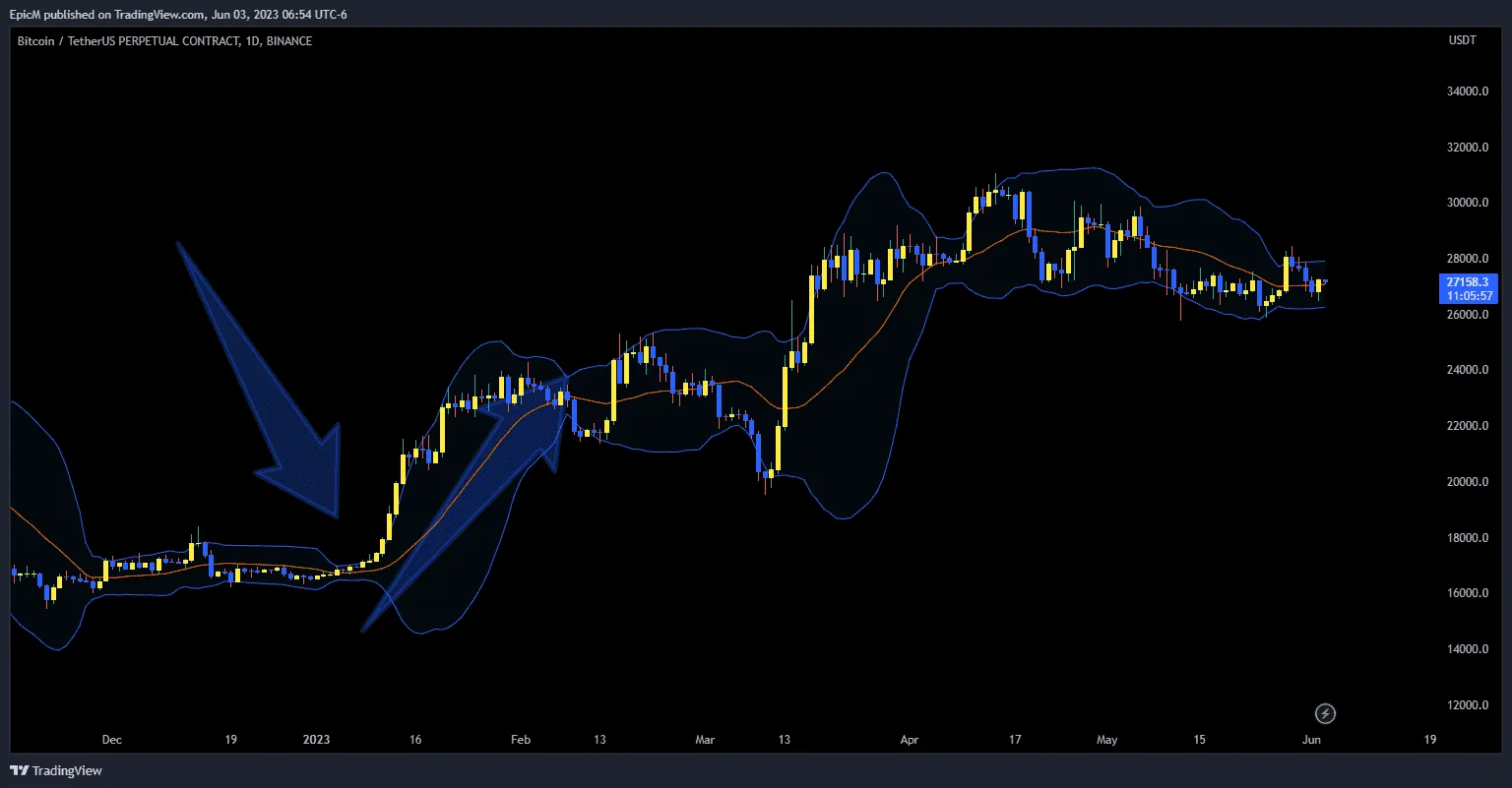
As a crypto trader, I’ve found that understanding the key concepts of Bollinger Bands as a technical indicator is crucial for success. This powerful tool helps me recognize market volatility shifts and potential breakout points, allowing me to make informed decisions in a fast-paced market.
To maximize my profits, I’ve learned to effectively combine Bollinger Bands with other indicators, creating a comprehensive trading strategy that keeps me ahead of the game.
Grasping the Key Concepts of Bollinger Bands as a Technical Indicator
Understanding the fundamentals of Bollinger Bands can enhance your technical analysis toolkit when navigating the volatile world of cryptocurrencies.
As a widely used trading indicator, Bollinger Bands encompass key concepts that can help you identify potential market trends and reversals, making them an invaluable asset in crypto day trading.
Developed by John Bollinger, this technical indicator comprises three bands: a simple moving average (SMA) as the middle band, and the upper and lower bands calculated by adding and subtracting a multiple of the standard deviation from the SMA.
By observing the bands’ fluctuations and their relationship with the price, you can gain insight into market volatility, support and resistance levels, and potential breakout points.
As you become proficient in interpreting Bollinger Bands, you’ll be better equipped to recognize market volatility shifts and potential breakout points, setting you on the path to mastering the art of crypto trading.
Recognizing Market Volatility Shifts and Potential Breakout Points
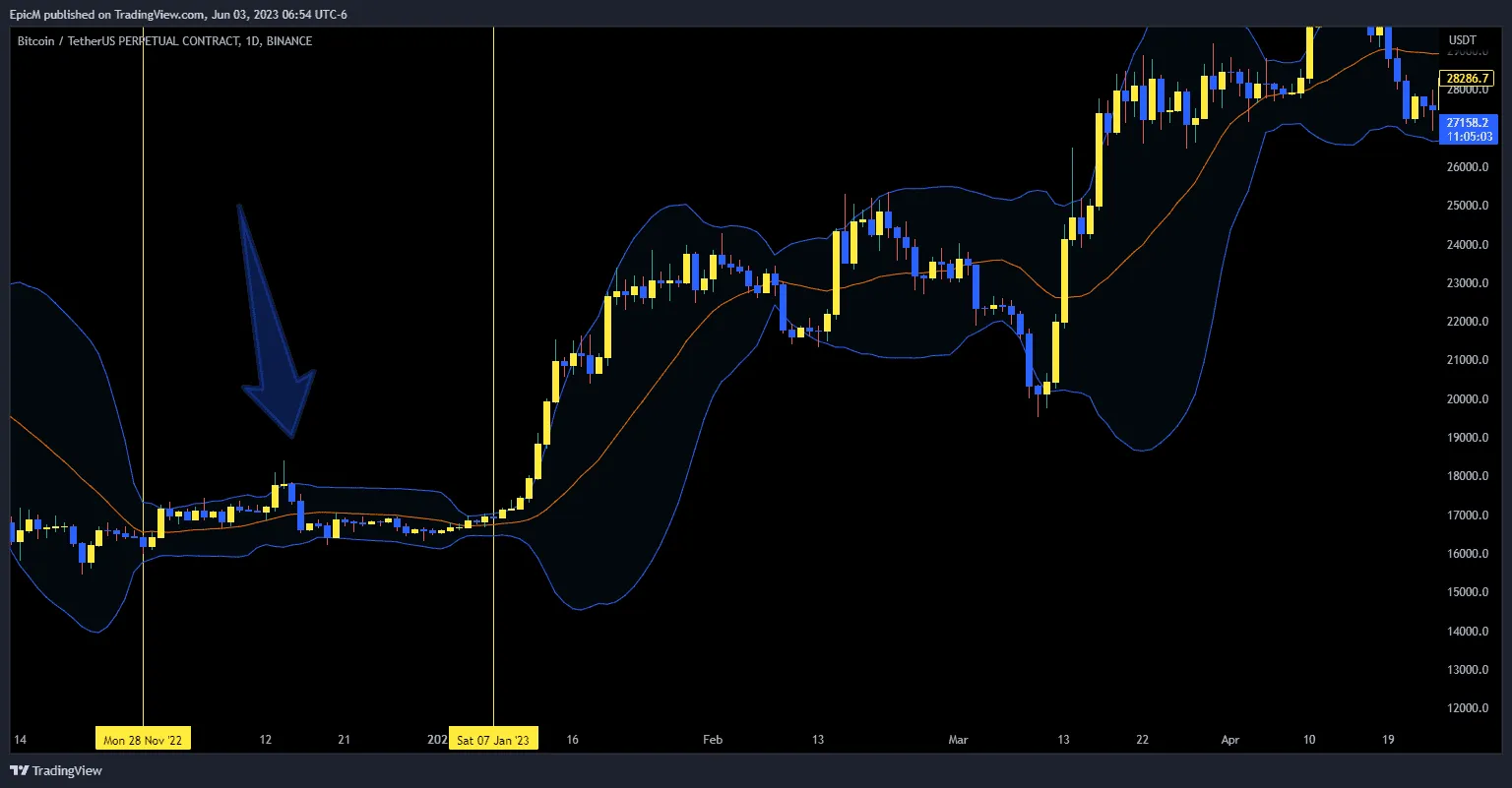
By harnessing the power of Bollinger Bands, you’ll unlock the secret to detecting market volatility shifts and spotting potential breakout points, paving your way to a more fruitful trading journey.
Analyzing the cryptocurrency market with this powerful tool allows you to pinpoint support and resistance levels, which are crucial in identifying the direction of future price movements. Keep a keen eye on the trading volume, as it can confirm the strength of a potential breakout or reversal.
Incorporate a momentum indicator like the Relative Strength Index (RSI) to validate the trends you observe within the Bollinger Bands; this will increase your confidence in making well-informed trading decisions.
Ultimately, understanding and interpreting these breakout points will set you on the path to success in the ever-changing world of cryptocurrency trading.
In the following section, we’ll dive deeper into how you can effectively combine Bollinger Bands with other indicators for profitable trades, arming you with a comprehensive arsenal of trading tools.
Effectively Combining Bollinger Bands with Other Indicators for Profitable Trades
You’re about to discover the magic of combining Bollinger Bands with other powerful tools, unlocking a world of profitable trades and catapulting your trading skills to new heights!
Effectively combining Bollinger Bands with the best indicators for crypto day trading, such as Moving Average Convergence Divergence (MACD), Relative Strength Index (RSI), and the Ichimoku Cloud, can help you identify trends, reversals, and potential entry and exit points with laser-like precision.
By using multiple indicators in conjunction, you’ll dramatically increase your chances of making profitable trades in the fast-paced and ever-changing world of crypto day trading.
So buckle up, as we’re about to delve into another powerful tool that will further improve your trading acumen: the Stochastic Oscillator Indicator!
Improve Your Trading Acumen with the Stochastic Oscillator Indicator
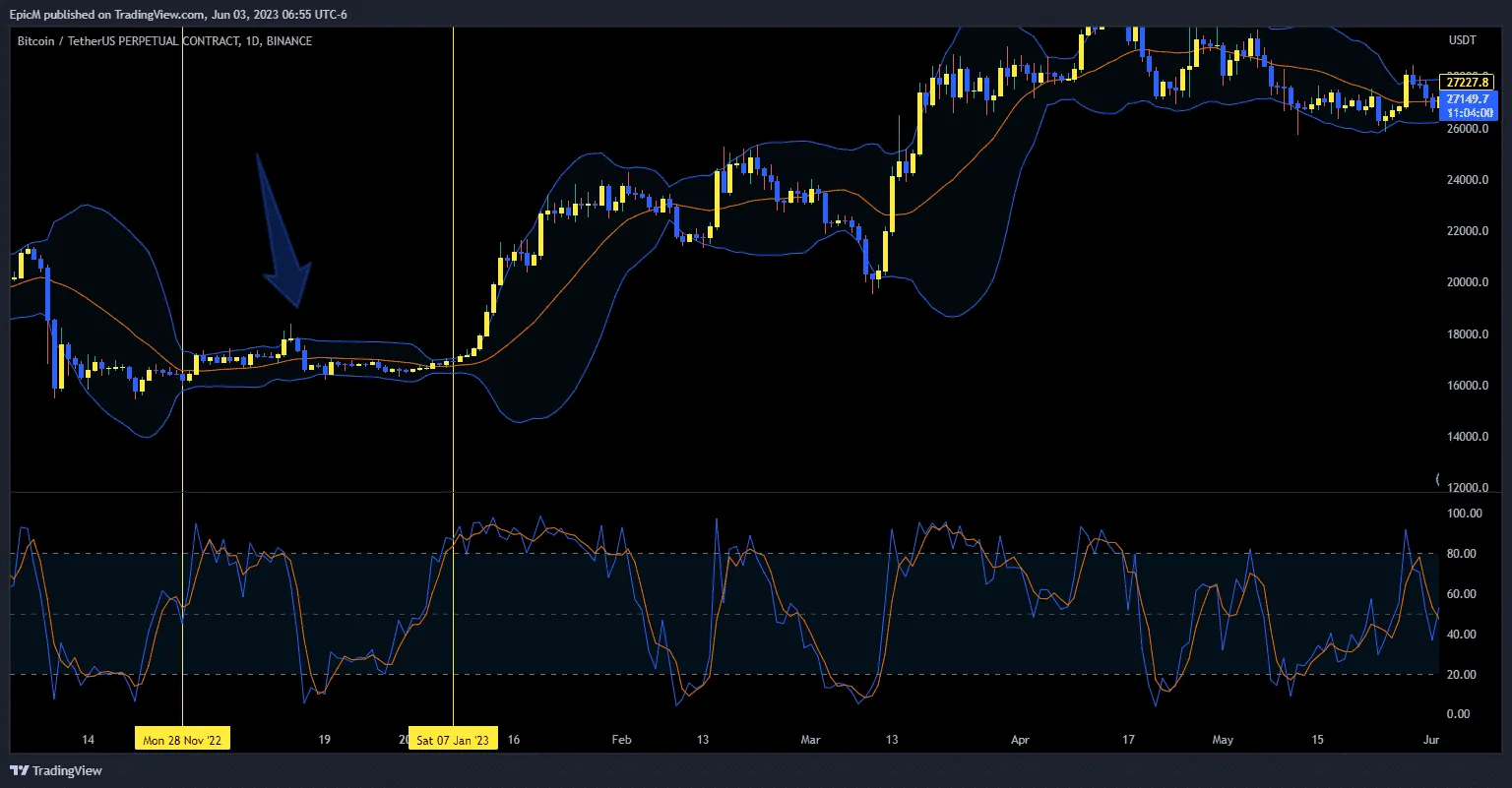
As a crypto trader, I’m always on the lookout for powerful tools to help improve my trading acumen. One such tool is the Stochastic Oscillator Indicator. This versatile indicator helps me identify overbought and oversold zones in the market, providing valuable insight into potential trading opportunities.
By combining the Stochastic Oscillator with other indicators, I’m able to fine-tune my trading strategies and optimize my results.
The Fundamentals of Stochastic Oscillators in Crypto Trading
Navigating the stormy seas of stochastic oscillators in digital currency trading can be your guiding star to a treasure trove of profit potential. As a savvy crypto trader, it’s essential to understand the fundamentals of stochastic oscillators and how they can enhance your trading strategy.
Here’s a quick rundown of the key concepts you need to grasp:
- Stochastic oscillators are a type of a technical indicator that compares a cryptocurrency’s closing price to its price range over a period.
- These trading indicators help you identify potential trend reversals and entry/exit points by measuring the momentum of price movements.
- Stochastic oscillators can be customized to fit your trading style, allowing you to tweak the parameters for optimal signal generation.
- The versatility of this tool makes it suitable for various crypto trading strategies, ranging from scalping to swing trading and beyond.
By mastering the art of stochastic oscillators, you’ll be well-equipped to identify overbought and oversold zones with ease, unlocking a world of opportunities to enhance your crypto trading prowess.
Stay tuned as we dive deeper into the realm of stochastic oscillator signals and how they can be your north star in the vast and volatile world of digital currency trading.
Identifying Overbought and Oversold Zones with Stochastic Oscillator Signals
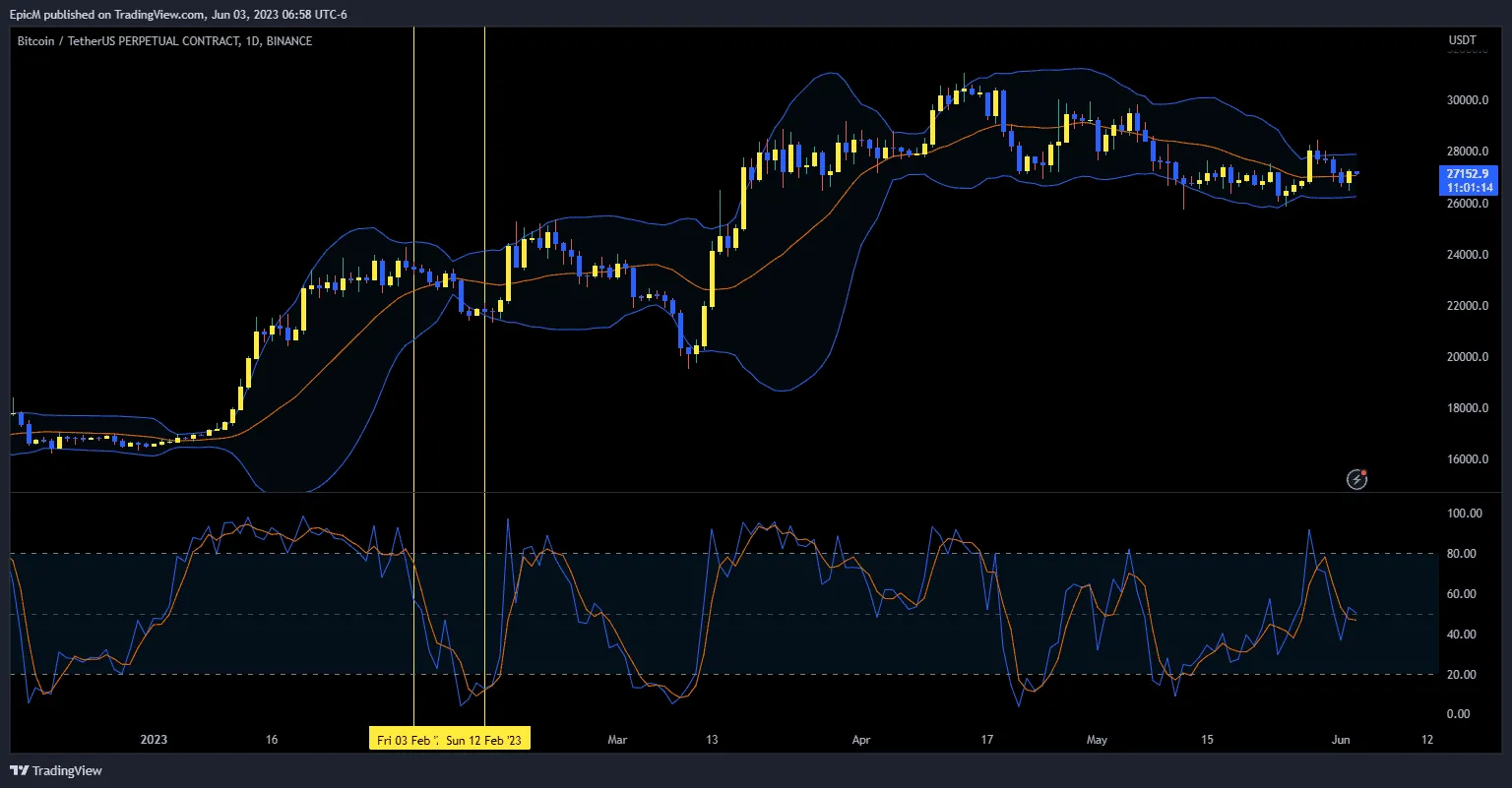
Now that we’ve delved into the fundamentals of stochastic oscillators in crypto trading, let’s dive into how we can use these oscillators to identify overbought and oversold zones.
As cryptocurrency traders, we’re always on the lookout for optimal entry and exit points when trading crypto. Stochastic oscillators play a crucial role in swing trading as they provide us with valuable information on market conditions. These oscillators help us recognize overbought and oversold zones by comparing the current closing price of an asset to its price range over a specific period.
By understanding these signals, we can make more informed decisions about when to enter or exit a trade. In the next section, we’ll explore how to apply the stochastic oscillator with other indicators for optimal results. This will ensure you’re well-equipped to take your crypto trading skills to the next level.
Applying the Stochastic Oscillator with Other Indicators for Optimal Results
You might wonder how to effectively combine the stochastic oscillator with other tools to enhance your decision-making in the ever-changing world of cryptocurrency trading. Integrating the stochastic oscillator with other indicators can help you achieve optimal results and improve your overall technical analysis.
Here’s a quick rundown of five popular indicators to consider using with the stochastic oscillator:
- Moving Averages (MA): Combine the stochastic oscillator with simple moving averages (SMA) or exponential moving averages (EMA) to identify trends and potential entry points. When the price crosses a moving average, it could signal a trend change, adding more confidence to your stochastic oscillator signals.
- Relative Strength Index (RSI): Use the RSI in tandem with the stochastic oscillator to confirm overbought and oversold conditions. When both indicators show similar readings, it provides stronger evidence for potential reversals in the market.
- Bollinger Bands: These bands can help you identify periods of high volatility and potential price reversals. When the price reaches the upper or lower band and the stochastic oscillator shows overbought or oversold conditions, it could signal a potential reversal.
- Fibonacci Retracements: Combining the stochastic oscillator with Fibonacci retracement levels can help you pinpoint potential support and resistance levels. When the price retraces to a Fibonacci level and the stochastic oscillator provides a reversal signal, it could show a high probability trade setup.
- Volume: Analyzing volume along with the stochastic oscillator can help validate price movements. If a price reversal is accompanied by high volume, it lends more credibility to the stochastic oscillator’s signal.
By incorporating these additional tools into your crypto day trading strategy, you can improve your overall technical analysis and make more informed decisions when navigating the volatile world of cryptocurrencies.
Frequently Asked Questions
How can I determine the optimal time frame for my crypto day trading strategy using these indicators?
Like a master painter handpicking the perfect brush size for their masterpiece, I too must choose the optimal time frame for my crypto day trading strategy to achieve the best results.
To do this, I’ll analyze the various indicators at my disposal, such as moving averages, RSI, and MACD, to find the one that speaks to my trading style and goals.
With each time frame offering unique opportunities and challenges, striking the right balance is essential in my quest for mastery.
As I continue to refine my skills and adapt to the ever-changing crypto landscape, I’ll uncover the ideal time frame that harmonizes with my strategy.
This will allow me to make more informed decisions and ultimately, achieve greater success in my day trading endeavors.
Are there specific cryptocurrencies that respond better to these indicators than others? If so, which ones are they and why?
As a seasoned crypto trader, I’ve observed that certain cryptocurrencies respond better to technical indicators than others. This is primarily because of factors such as liquidity, volatility, and market sentiment.
For instance, widely traded cryptos like Bitcoin (BTC) and Ethereum (ETH) often show more consistent patterns and clearer signals, making them ideal candidates to apply these indicators for day trading. Lesser-known altcoins might not exhibit the same level of predictability, making it trickier to apply technical analysis.
Ultimately, it’s crucial to stay informed, practice, and experiment with different indicators and assets to discover which combinations work best for your unique day trading strategy.
How can I combine two or more of these indicators to create a more comprehensive and effective trading strategy?
By combining two or more indicators, I can create a more comprehensive and effective trading strategy that maximizes my profits and minimizes my risks. One way to do this is by using a moving average (MA) to identify the overall trend, and then employing a relative strength index (RSI) to pinpoint the best entry and exit points.
When the MA shows an upward trend and the RSI signals an oversold condition, I can confidently buy in, knowing that I’m riding the wave of a bullish market. Conversely, if the MA shows a downward trend and the RSI shows overbought conditions, I’ll know it’s time to sell and protect my profits.
Experimenting with different combinations of indicators helps me fine-tune my strategy and ultimately achieve trading mastery.
Are there any common pitfalls or mistakes that traders should know of when using these indicators for day trading in the crypto market?
When I first started day trading in the crypto market, I felt like a kid in a candy store, surrounded by a myriad of colorful indicators promising sweet profits. But just like eating too many sweets can lead to a stomachache, relying solely on these indicators can lead to painful losses in trading.
The most common pitfall is putting too much faith in a single indicator, instead of using a combination of them to create a more comprehensive strategy. Traders often overlook the importance of risk management, focusing only on potential gains.
Remember, even the best indicators won’t guarantee success; it’s crucial to remain disciplined, adaptable, and to learn from your experiences to truly master the art of crypto day trading.
Can these indicators be effectively applied to other forms of trading, such as swing trading or long-term investing, besides day trading?
Absolutely! These indicators can be effectively applied to other forms of trading, such as swing trading or long-term investing, besides day trading.
As a trader, it’s crucial to understand that each trading style has its unique timeframes and goals, but the core principles of technical analysis remain the same. By adapting and customizing these indicators to suit your specific trading strategy, you can gain valuable insights and make more informed decisions in the market.
So, whether you’re a swing trader looking for the next big trend or a long-term investor seeking solid entry and exit points, these indicators can definitely help you achieve your trading objectives and strive for mastery in the ever-changing world of cryptocurrencies.
Conclusion
It amazed me to find out that 80% of all crypto traders use technical analysis, including the indicators we’ve just discussed, to make informed decisions. This just goes to show the significance of understanding and employing these tools in our own trading strategies.
In the end, it’s essential that we remain adaptable and constantly work on improving our crypto trading acumen. By leveraging these powerful indicators, we can stay ahead of the curve and make more informed decisions.
